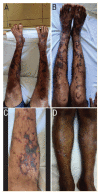Leukocytoclastic Vasculitis: A peculiar presentation of scrub typhus
- PMID: 36865420
- PMCID: PMC9974041
- DOI: 10.18295/squmj.1.2022.011
Leukocytoclastic Vasculitis: A peculiar presentation of scrub typhus
Abstract
Scrub typhus is a disease endemic to the Indian subcontinent caused by the obligate intracellular pleomorphic organism, Orientia tsutsugamushi. Scrub typhus, among other acute febrile illnesses, manifests as prodromal symptoms of fever, malaise, myalgia and anorexia followed by a distinct maculopapular rash, hepatosplenomegaly and lymphadenopathy. We report the case of a patient presenting to tertiary care hospital in southern India in 2021 who developed a rare cutaneous vasculitis secondary to infection with Orientia tsutsugamushi. After performing the Weil-Felix test, a diagnostic titre of >1:640 against OXK was obtained. Furthermore, a skin biopsy was carried out which confirmed the diagnosis of leukocytoclastic vasculitis. The patient was treated with doxycycline and showed drastic improvement in his symptoms.
Keywords: Doxycycline; India; Rickettsia; Scrub Typhus; Vasculitis.
© Copyright 2023, Sultan Qaboos University Medical Journal, All Rights Reserved.
Figures


Comment in
-
Re: Leukocytoclastic Vasculitis: A peculiar presentation of scrub typhus.Sultan Qaboos Univ Med J. 2023 Aug;23(3):427-428. doi: 10.18295/squmj.3.2023.017. Epub 2023 Aug 28. Sultan Qaboos Univ Med J. 2023. PMID: 37655080 Free PMC article. No abstract available.
References
-
- Chogle AR. Diagnosis and treatment of scrub typhus--the Indian scenario. J Assoc Physicians India. 2010;58:11–2. - PubMed
Publication types
MeSH terms
Substances
Supplementary concepts
LinkOut - more resources
Full Text Sources
